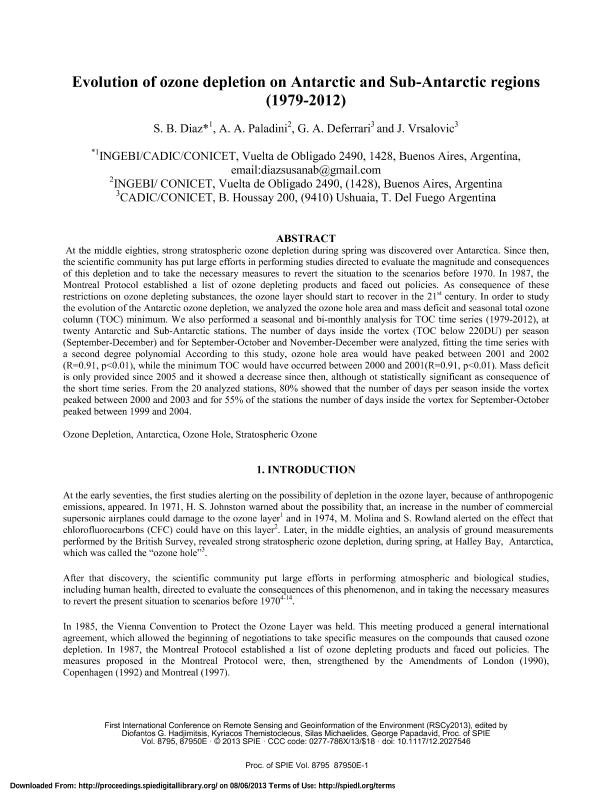Mostrar el registro sencillo del ítem
dc.contributor.author
Diaz, Susana Beatriz

dc.contributor.author
Paladini, Alejandro Alberto

dc.contributor.author
Deferrari, Guillermo Alejandro

dc.contributor.author
Vrsalovic, Jazmin

dc.date.available
2016-02-03T20:33:09Z
dc.date.issued
2013-08
dc.identifier.citation
Diaz, Susana Beatriz; Paladini, Alejandro Alberto; Deferrari, Guillermo Alejandro; Vrsalovic, Jazmin; Evolution of ozone depletion on Antarctic and Sub-Antarctic regions (1979-2012); International Society for Optics and Photonics; Proceedings of SPIE; 8795; 8-2013; 1-9
dc.identifier.uri
http://hdl.handle.net/11336/4018
dc.description.abstract
At the middle eighties, strong stratospheric ozone depletion during spring was discovered over Antarctica. Since then, the scientific community has put large efforts in performing studies directed to evaluate the magnitude and consequences of this depletion and to take the necessary measures to revert the situation to the scenarios before 1970. In 1987, the Montreal Protocol established a list of ozone depleting products and faced out policies. As consequence of these restrictions on ozone depleting substances, the ozone layer should start to recover in the 21st century. In order to study the evolution of the Antarctic ozone depletion, we analyzed the ozone hole area and mass deficit and seasonal total ozone column (TOC) minimum. We also performed a seasonal and bi-monthly analysis for TOC time series (1979-2012), at twenty Antarctic and Sub-Antarctic stations. The number of days inside the vortex (TOC below 220DU) per season (September-December) and for September-October and November-December were analyzed, fitting the time series with a second degree polynomial According to this study, ozone hole area would have peaked between 2001 and 2002 (R=0.91, p<0.01), while the minimum TOC would have occurred between 2000 and 2001(R=0.91, p<0.01). Mass deficit is only provided since 2005 and it showed a decrease since then, although ot statistically significant as consequence of the short time series. From the 20 analyzed stations, 80% showed that the number of days per season inside the vortex peaked between 2000 and 2003 and for 55% of the stations the number of days inside the vortex for September-October peaked between 1999 and 2004.
dc.format
application/pdf
dc.language.iso
eng
dc.publisher
International Society for Optics and Photonics
dc.rights
info:eu-repo/semantics/openAccess
dc.rights.uri
https://creativecommons.org/licenses/by-nc-sa/2.5/ar/
dc.subject
Ozone Depletion
dc.subject
Antarctica
dc.subject
Ozone Hole
dc.subject
Stratospheric Ozone
dc.subject.classification
Meteorología y Ciencias Atmosféricas

dc.subject.classification
Ciencias de la Tierra y relacionadas con el Medio Ambiente

dc.subject.classification
CIENCIAS NATURALES Y EXACTAS

dc.title
Evolution of ozone depletion on Antarctic and Sub-Antarctic regions (1979-2012)
dc.type
info:eu-repo/semantics/article
dc.type
info:ar-repo/semantics/artículo
dc.type
info:eu-repo/semantics/publishedVersion
dc.date.updated
2016-03-30 10:35:44.97925-03
dc.identifier.eissn
1996-756X
dc.journal.volume
8795
dc.journal.pagination
1-9
dc.journal.pais
Estados Unidos

dc.journal.ciudad
Bellingham
dc.description.fil
Fil: Diaz, Susana Beatriz. Consejo Nacional de Investigaciones Científicas y Técnicas. Instituto de Investigaciones en Ingeniería Genética y Biología Molecular; Argentina. Consejo Nacional de Investigaciones Científicas y Técnicas. Centro Austral de Investigaciones Científicas; Argentina
dc.description.fil
Fil: Paladini, Alejandro Alberto. Consejo Nacional de Investigaciones Científicas y Técnicas. Instituto de Investigaciones en Ingeniería Genética y Biología Molecular; Argentina
dc.description.fil
Fil: Deferrari, Guillermo Alejandro. Consejo Nacional de Investigaciones Científicas y Técnicas. Centro Austral de Investigaciones Científicas; Argentina
dc.description.fil
Fil: Vrsalovic, Jazmin. Consejo Nacional de Investigaciones Científicas y Técnicas. Centro Austral de Investigaciones Científicas; Argentina
dc.journal.title
Proceedings of SPIE
dc.relation.alternativeid
info:eu-repo/semantics/altIdentifier/url/http://spie.org/Publications/Proceedings/Paper/10.1117/12.2027546
dc.relation.alternativeid
info:eu-repo/semantics/altIdentifier/doi/http://dx.doi.org/10.1117/12.2027546
dc.relation.alternativeid
info:eu-repo/semantics/altIdentifier/issn/1996-756X
Archivos asociados
